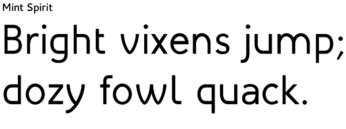11 free-licensed fonts for everyday use

Off the Beat: Bruce Byfield's Blog
Spending the last nine months writing a book about LibreOffice, I've rediscovered typography. I've also discovered that as the free font movement enters its second decade, it has evolved from an idea as tentative as free software was in its beginning to a thriving community that gives users a reasonable selection of fonts.
However, as much of a gift as Google Fonts or the Open Font Library can be to graphic designers, they can also be nightmares for average users. When you have hundred of fonts to choose from, how do you choose which ones are right for you?
You may not have any problems with the pragmatic choices. Want fonts whose characters occupy the same space as Times Roman, Arial, and Courier New? Then try the Liberation typefaces. A font with broad Unicode support? Then try those developed by SIL International, one of the pioneers of free fonts and their licensing.
However, aesthetics are another matter. After the first two dozen fonts or so, even an expert's eye begins to fail. Nor is the situation helped by the fact that some free fonts are distinguished mostly by a lack of distinction.
A decade ago, the problem was a lack of choice. Today, however, the problem is too many choices.To get you started, here are eleven high-quality fonts that are useful in everyday documents:
11. Fanwood: Fanwood closely resembles Eric Gill's Joanna in letter shape, size, and spacing. A simple, elegant font, it is ideal for long bodies of text. It is available in regular and italic weights only, but a darker version, Fernwood Text, has been designed for e-readers.

10. Goudy Bookletter 1911: The best of the free fonts inspired by font designer Frederick Goudy, this font has an old-fashioned or formal look, especially with its old style figures. Use it for long bodies of text.

9. Gentium: One of the first quality fonts to use the Open Font License, Gentium has a strong calligraphic look to its characters that makes it feel informal. A versatile font, it can be used at almost any size, and is equally useful for body text and headings. The italic is especially graceful, even when used in a bold weight.

8. Baskervald ADF Standard: Baskerville is widely considered a timeless font, and is one of the best known of 18th Century fonts. The Baskervald ADF is a copy of Baskerville that adhere closely to the metrics of the original.

7. Quattrocento: Available as both a serif and a sans serif font, Quattrocento is a reliable work-horse of a font, suitable for almost any purpose. Its large x-height (the height of letters like "m" or "r") makes it highly readable, as well as a good choice at smaller font sizes.

6. Mint Spirit: Designed as an unofficial font for the Linux Mint distribution, Mint Spirit is a modern sans serif suitable for online display and headings. It is available in two variations: the rounder, slightly looser-spaced Mint Spirit and the squarer, tighter-spaced Mint Spirit No. 2.

5. NeoGothis ADF Standard: This font is an eccentric mixture of two trends from the early 20th Century. The lower case letters are geometric, resembling Futura or Avenir. The upper case leters are no less geometric, but the unusual shapes of letters like "A," "M," and "N" seem to owe more to the Arts and Craft Movement fonts. Somehow, the combo works.

4. Ubuntu: Nine months in development, the Ubuntu font is by far the best thing to come out of the Unity interface. A contemporary sans serif, the only drawback is that it is associated so closely with Ubuntu that you want to make sure that you use it appropriately -- and not, for instance, for a manual for Red Hat. Its light weights and monospaced versions are especially beautiful.

3. Gillius ADF Standard: Gillius is a modern successor to Eric Gill's Gill Sans, the quintessential English font of the twentieth century. Like its parent, Gillus is a sans serif font that can also be used for body text, with very clean lines.

2. Cantarell: The default font for GNOME 3, Cantarell is a contemporary humanist sans-serif, with regular, rounded characters. It is especially useful online, and/or at small sizes. However, its oblique font is so sharply angled as to be hard to read -- especially in contrast to the Regular and Bold weights.

1. Maven Pro: Maven Pro is billed as an all-purpose sans serif. However, it is less suitable for body text than Gill Sans or Gillius, and probably best reserved for headings.

The new professionalism
Some of these fonts are not perfect -- but, then the same could be said of many commercial fonts. Flaws and all, these eleven fonts are enough to prove once and for all that you don't need to pay to obtain quality fonts.
True, at least a dozen proprietary fonts exist for every free-licensed fonts. Also, traditional font foundries have the advantage of being able to license the original designs for some of the best known fonts. Still, today it is possible to do professional work using only free fonts -- something that was impossible ten years ago.
comments powered by Disqus